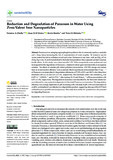| dc.description.abstract | Paraoxon is an emerging organophosphate pollutant that is commonly used as a pesticide and a drug, hence increasing the risk of contamination of water supplies. Its intensive use for vector control has led to pollutions in soil and water. Paraoxon is very toxic, with an LD50 of 2 to 30 mg/kg in rats. It can be metabolized in the body from parathion; thus, exposure can lead to serious health effects. In this study, zero valent iron (Fe°/ZVI NPs) nanoparticles were synthesized and investigated for the degradation of Paraoxon, a chemical warfare agent and insecticide, in an aqueous solution. The effects of solution pH, initial pollutant concentration, ZVI NPs dosage and contact time on mineralization efficiency were examined. Batch experiments demonstrated that 15 mg L−1 of Paraoxon was mineralized at degradation efficiencies of 75.9%, 63.9% and 48.9% after three-hour treatment with 6.0, 4.0 and 2.0% w/v Fe°, respectively. The calculated kinetic rate constant kobs was 0.4791 h−1, 0.4519 h−1 and 0.4175 h−1 after treating 10, 15 and 20 mg L−1 of Paraoxon solution with 6.0% w/v Fe, respectively. The degradation dynamics were described by the first-order kinetic law as evidenced by rate constants independent of the initial Paraoxon concentration. The degradation efficiency was strongly dependent on pH, increasing with a decrease in pH, with maximum removal at pH 4. p-nitrophenol was detected as a degradation product, suggesting cleavage of the O-P bond and hydrolysis as possible reaction processes. This study showed that Fe° particles have the potential for degrading Paraoxon. | en_US |

